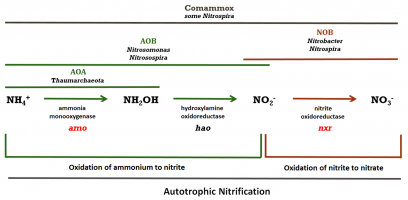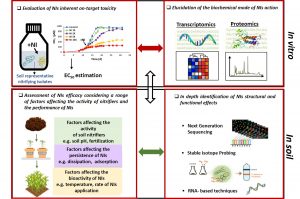Nitrification is the rate-limiting step of N cycling. It is performed in two successive steps by ammonia oxidizing bacteria (ΑΟΒ) or archaea (ΑΟΑ), and nitrite-oxidizing bacteria (ΝΟΒ). Recently, bacteria of the genus Nitrospira sp. (formerly known as ΝΟΒ) were found to be able to perform the complete oxidation of ammonia to nitrate, and they were named Comammox (Complete-ammonia-oxidation). Nitrification could have undesirable environmental effects leading to the production of NO3 which could contaminate groundwater and air (via the process of denitrification). Nitrification inhibitors (NI) are used as supplements in slow-release fertilizers (nitrapyrin and DCD) to reduce the rate of nitrification and hence to improve N use efficiency and reduce N losses (ΝΟ3-, ΝxO).

The majority of currently available NIs demonstrate a selective activity towards ΑΟΒ, while their impact on AOA is either limited or unknown. In addition, we know nothing about the effects of NI on other functional microbial groups of N cycling and on the non-target soil microbiota. Ethoxyquin (EQ), an antioxidant commonly used in fruit packaging plants, and its main oxidative derivatives quinone imine (QI) (major metabolite) and 2,4-dimethyl-6-ethoxyquinoline (EQNL) (minor metabolite) showed a clear inhibitory effect on nitrification. In vitro tests with pure cultures of AOA and AOB from soil showed that EQ, through QI, was the most effective inhibitor of AOA while it was able inhibit also AOB at equivalent dose rates to other NIs like DCD and DMPP. tWe are currently focusing on:
- testing the activity of EQ and QI under soil conditions comparatively to other established NIs like nitrapyrin, DCD, DMPP
- develop in collaboration with Phytothreptiki SA., novel Nitrogen Fertilizers implemented with EQ (either alone or in combination with other NIs with higher activity on AOB) and testing their performance under practical field soil conditions
- determine the mode of action of EQ and QI at cellular level via proteomic approaches

Our group has a wide collection of soil derived AOA, AOB and NOB which maintains and is using in pure cultures including:
- Candidatus Nitrosocosmicus franklandus strain C13 (AOA)
- Candidatus Nitrosotalea sinensis strain Nd2 (AOA)
- Nitrosospira multiformis (AOB)
- Nitrosomonas europaea (AOB)
- Nitrosomonas communis (AOB)
- Nitrosomonas eutropha (AOB)
- Nitrosomonas nitrosa (AOB)
- Nitrobacter , (NOB)
- Nitrobacter hamburgensis (NOB)
- Nitrobacter vulgaris (NOB)
- Nitrobacter winogradski (NOB)
- Nitrospira, (NOB)
- Nitrispira inopinata (Comammox bacterium)
Collaborators: Our lab works in close collaboration in this research axis with the group of Dr Graeme Nicol (Ecole Central del Lyon) and Dr Evangelia Papadopoulou, Assistant Prof. in Environmental Microbiology in the Department of Environmental Sciences of the University of Thessaly ex-member of our group.
Funding
![]() HFRI Call for the support of postdoctoral fellows, Looking up for novel nitrification inhibitors: New stories with old compounds. Funding Body: Hellenic Foundation for Research and Innovation (HFRI), Greece. Total Funding 200000 €. Duration: 2018-2021
HFRI Call for the support of postdoctoral fellows, Looking up for novel nitrification inhibitors: New stories with old compounds. Funding Body: Hellenic Foundation for Research and Innovation (HFRI), Greece. Total Funding 200000 €. Duration: 2018-2021
Publications
- Papadopoulou E.S., Tsachidou P., Sulowic S., Menkissoglu-Spiroudi U., Karpouzas D.G., (2016) Land spreading of wastewaters from the fruit packaging industry and potential effects on soil microbes: Effects of the antioxidant ethoxyquin and its metabolites on ammonia oxidizers. Applied and Environmental Microbiology 82: 747-755
- Papadopoulou E.S., Bachtsevani E., Lampronikou E., Adamou E., Katsaouni A., Vasileiadis S., Thion C., Menkissoglou-Spiroudi U., Nicol G.W., Karpouzas D.G, (2020) Comparison of novel and established nitrification inhibitors relevant to agriculture on soil ammonia- and nitrite oxidizing isolates. Frontiers in Microbiology 11: 2795
- Bachtsevani E., Papadopoulou E.S., Papazlatani C., Rousidou C., Lampronikou E., Menkissoglou-Spiroudi U., Nicol GW., Karpouzas D.G., (2021) The impact of the nitrification inhibitor 3,4-Dimethylpyrazole phosphate (DMPP) on target and non-target microbial groups in two agricultural soils of contrasting pH submitted
- Papadopoulou ES., Bachtsevani E., Papazlatani C., Rousidou C., Brouziotis A., Lambronikou E., Tsiknia M., Menkissoglou-Spiroudi U., Ehaliotis C., Philippot L., Nicol G.W., Karpouzas D.G., (2021) Quinone imine, dicyandiamide (DCD) and nitrapyrin effects on target and non-target microbial groups under contrasting soil pH submitted
Personnel
Dr Athanasia Katsoula, Postdoc Fellow
Dr Konstantina Rousidou, Postdoc Fellow
Maria Kolovou, PhD student